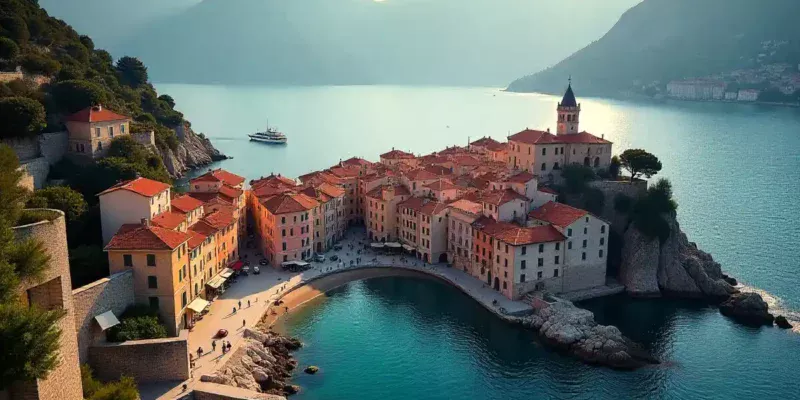
Kotora Melnkalne, often used as a poetic or localized phrase for Kotor, Montenegro, has quickly become one of Europe’s most talked-about travel destinations in 2025. With its UNESCO-listed Old Town, dramatic bay views, and mix of medieval and Venetian influences, this Adriatic gem blends history, culture, and natural beauty. Whether you’re seeking ancient fortresses, vibrant festivals, or tranquil seaside escapes, Kotora Melnkalne offers something for every traveler.
This stunning coastal destination sits along the Bay of Kotor, often called Europe’s southernmost fjord. The medieval city walls wrap around cobblestone streets that have witnessed centuries of maritime history. Montenegro’s tourism has been growing rapidly, with Kotora Melnkalne leading the charge as a must-visit European destination combining affordable prices with breathtaking scenery.
What is Kotora Melnkalne?
Kotora Melnkalne represents a creative interpretation of Kotor, Montenegro’s most famous coastal town. The phrase combines “Kotora,” a poetic variant of Kotor, with “Melnkalne,” meaning “black mountain” in Latvian, which directly translates Montenegro’s literal meaning. This linguistic blend captures the essence of Montenegro’s dramatic landscape where dark mountains meet the sparkling Adriatic Sea.
Kotor itself traces its roots back over 2,000 years, originally founded as a Roman settlement. The city flourished under Venetian rule from 1420 to 1797, leaving behind stunning architecture that defines today’s Old Town. The Natural and Culturo-Historical Region of Kotor earned UNESCO World Heritage status in 1979, recognizing its outstanding universal value and ensuring preservation for future generations.
Travel bloggers and tourism marketers often use “Kotora Melnkalne” as an SEO-friendly phrase to capture searches for this Montenegro destination. The poetic name evokes the mystical quality of the Bay of Kotor, where morning mist rises from calm waters and ancient bell towers pierce the skyline.
Why Visit Kotora Melnkalne in 2025?
Montenegro tourism has experienced remarkable growth, with 2025 projections showing record-breaking visitor numbers. Kotora Melnkalne sits at the heart of this tourism boom, offering travelers an authentic Adriatic experience without the crowds and prices of neighboring Croatia or Italy. The Bay of Kotor provides stunning scenery that rivals famous destinations like the Amalfi Coast but remains refreshingly accessible.
The UNESCO heritage designation continues to draw culture enthusiasts who appreciate well-preserved medieval architecture. St John’s Fortress towers above the Old Town, offering panoramic views that span the entire bay and surrounding mountains. Visitors can walk the same cobblestone streets where merchants and sailors once conducted business.
Kotor’s strategic location makes it perfect for exploring wider Montenegro and the western Balkans. Day trips to Perast, Our Lady of the Rocks, and Lovćen National Park provide diverse experiences from the same base. Current travel trends favor destinations that offer both natural beauty and cultural depth, making Kotora Melnkalne perfectly positioned for 2025’s travel preferences.
Top Things to Do in Kotora Melnkalne
Walking through Kotor’s Old Town feels like stepping into a living museum where every stone tells a story. The Cathedral of Saint Tryphon, built in 1166, showcases Romanesque architecture with twin bell towers that define the city’s skyline. Narrow alleys lead to hidden squares where local cafes serve traditional Montenegrin coffee alongside views of ancient church facades.
Climbing St John’s Fortress provides the quintessential Kotora Melnkalne experience, though the steep path challenges even fit hikers. The fortress walls snake up the mountainside for over 1,400 meters, offering increasingly spectacular views with each step. Early morning climbs avoid crowds and heat while providing perfect lighting for photography.
Boat trips to Perast and Our Lady of the Rocks island create unforgettable memories of the bay’s most picturesque spots. Perast’s baroque architecture reflects centuries of maritime wealth, while the artificial island houses a church built by sailors over 200 years. Local cuisine experiences showcase Montenegro’s position at the crossroads of Mediterranean and Balkan influences through traditional konoba restaurants.
Best Time to Visit Kotora Melnkalne
May through September represents peak season for Kotora Melnkalne, offering warm weather perfect for outdoor activities and swimming. July and August bring the highest temperatures and largest crowds, especially when multiple cruise ships dock simultaneously. These busy months provide vibrant atmosphere but require advance booking for accommodation.
Shoulder seasons of April-May and September-October offer ideal conditions for many travelers seeking comfortable temperatures without summer crowds. Spring brings blooming Mediterranean vegetation and pleasant hiking weather, while autumn provides warm sea temperatures and stable weather patterns. Hotel rates drop significantly outside peak season.
Winter visits reveal a different side of Kotora Melnkalne, with fewer tourists and authentic local atmosphere. The mild Mediterranean climate allows year-round exploration, with temperatures rarely dropping below freezing. Cruise season runs from April through October, with peak frequency during summer months.
Where to Stay in Kotora Melnkalne
Boutique hotels within Kotor’s Old Town offer unparalleled atmosphere, with many properties housed in restored medieval buildings. These intimate accommodations provide easy access to restaurants and attractions but often feature higher prices and limited parking. Room availability fills quickly during peak season, making advance booking essential.
Waterfront accommodations outside the city walls combine convenience with modern amenities and often include parking facilities. These hotels offer bay views without the premium prices of Old Town locations. Many feature swimming pools that provide relaxation after busy sightseeing days.
Airbnb options throughout the Kotor area provide authentic local experiences and often represent excellent value for families or groups. Traditional stone houses converted to vacation rentals offer unique character while providing kitchen facilities and local neighborhood experiences.
How to Get to Kotora Melnkalne
Tivat Airport sits just 15 kilometers from Kotor, making it the most convenient arrival point for international visitors. Regular flights connect to major European cities during peak season, with journey times under 30 minutes to most Kotor accommodations. Podgorica Airport serves as Montenegro’s primary international gateway, located 90 kilometers from Kotor with good road connections.
Dubrovnik Airport in Croatia provides another viable option, especially for travelers combining both destinations. The two-hour drive includes spectacular coastal scenery along the Adriatic highway. Ferry connections link Kotor to Italian ports during summer months, providing romantic arrival options for travelers seeking unique transportation experiences.
Road trip opportunities abound along Montenegro’s coast, with scenic routes connecting Kotor to other Adriatic destinations. Public transport includes regular bus services to major regional cities, making car-free travel perfectly feasible for budget-conscious visitors.
Travel Costs and Budget Tips for Kotora Melnkalne
Accommodation costs in Kotora Melnkalne vary significantly by season and location, with budget options starting around 30 euros per night for basic guesthouses. Mid-range hotels typically cost 60-120 euros nightly, while luxury properties can exceed 300 euros during peak season. Old Town locations command premium prices but offer unmatched atmosphere.
Dining expenses remain reasonable compared to Western European standards, with traditional konoba meals costing 15-25 euros per person including local wine. Street food and casual dining options provide excellent value, while upscale restaurants charge 30-50 euros for multi-course meals with bay views.
Transportation costs within the Kotor area remain minimal, with most attractions accessible on foot from Old Town accommodations. Boat excursions to Perast typically cost 10-15 euros per person for group tours. Budget travelers can maximize value by visiting during shoulder seasons when prices drop significantly.
Sustainable Tourism in Kotora Melnkalne
Cruise ship tourism brings economic benefits but creates challenges for Kotor’s historic infrastructure. UNESCO monitoring ensures that tourism growth doesn’t compromise the World Heritage site’s integrity. Local authorities implement crowd management strategies during peak periods, including timed entry systems for popular attractions.
Conservation efforts focus on maintaining medieval architecture while accommodating modern tourism needs. Restoration projects use traditional materials and techniques to preserve authentic character. Eco-friendly activities encourage visitors to appreciate natural beauty while minimizing environmental impact through hiking trails and bicycle rentals.
Responsible travel practices include supporting local businesses, respecting cultural sites, and following designated paths. Travelers can contribute positively by choosing locally-owned accommodations and dining at family restaurants, ensuring tourism revenue benefits local communities.
Final Travel Tips for Kotora Melnkalne
Safety considerations in Kotora Melnkalne remain minimal, with Montenegro maintaining low crime rates. The fortress climb requires proper footwear and water, especially during hot summer months. Essential apps include offline maps for navigating narrow Old Town streets and translation tools for communicating with locals.
Local etiquette emphasizes respect for religious sites, with modest dress required for church visits. Restaurant dining typically occurs later than Northern European schedules, with dinner service beginning around 7 PM. Currency considerations include euro adoption, making transactions simple for European visitors.
Kotora Melnkalne represents everything modern travelers seek in European destinations: authentic history, stunning natural beauty, affordable prices, and genuine cultural experiences. Whether seeking adventure, relaxation, culture, or cuisine, this Montenegro gem delivers experiences that exceed expectations while remaining accessible to travelers of all budgets.




